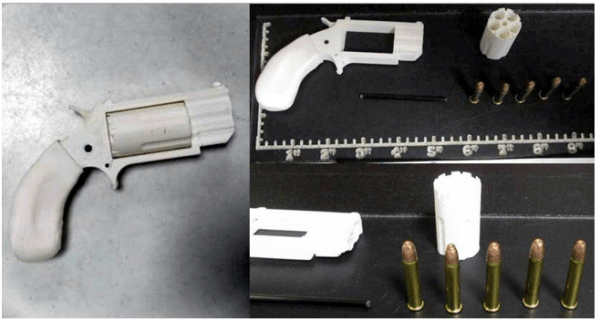
This 3D revolver and five rounds of .22 Magnum ammunition were detected by the TSA at an airport in 2016. But critics say these guns are “invisible” to metal detectors. (Image courtesy TSA)
Gun control proponents, including some in the press, experienced a couple of embarrassing setbacks last week, thanks to a report from the Transportation Safety Administration publicized by CBS News, and an editorial in the Walla Walla Union Bulletin relating to an anti-gun-rights initiative in Washington state.
In the midst of last week’s hysteria over 3D plastic guns, CBS News reported that, over the past two years, the Transportation Safety Administration had intercepted “thousands of guns” at security checkpoints, including “a handful (that) were created with a 3D printer.” The story was accompanied by an image showing a tiny five-shot revolver and five .22 Magnum cartridges that were detected. The gun looks like a knock-off of a North American Arms mini-revolver.
CBS quoted TSA Assistant Administrator Michael Bilello, who said in a statement, “TSA Officers are trained and on the lookout for 3D guns. We have proven detection capabilities and screening protocols in place. In the world of airport and aviation security, ‘a gun is a gun.’”
That rather debunks an argument in a Seattle Times editorial, along with similar assertions in other media, that 3D guns – also called “ghost guns” – are “invisible to metal detectors.” If that were true, these plastic guns rounded up by TSA would have gotten through the security checkpoints, would they not?
The revolver shown was detected in August 2016, virtually two years before the brouhaha erupted last week over the planned release of, and quick court action against, 3D printing technology and blueprints by a Texas-based firm, Defense Distributed, founded by Cody Wilson. A federal judge has schedule another hearing on the matter later this week in Seattle.
CBS further reported that “in December 2016 and January 2018, 3D-printed parts of so-called assault-style weapons known as “lower receivers” were found in carry-on bags at Las Vegas’ McCarran International Airport.” That would seem to rebut comments made by perennial anti-gun Connecticut Sen. Richard Blumenthal, who claimed that “undetectable” AR15 rifles are “coming to a theater near you; coming to a school near you” in a press event aired by ABC News.
While all of this was going on, a newspaper in far south-central Washington State said in an editorial that a controversial gun control initiative aimed at stripping young adults of their Second Amendment right to keep and bear arms should be kept off the November ballot.
The newspaper editorial noted that Secretary of State Kim Wyman “had concerns about whether the format of the petitions was constitutional.” State law requires that petitions include a “readable, full, true and correct” version of the initiative printed on the reverse side, the newspaper said. That was not the case, however, resulting in two separate legal challenges, one filed by gun rights advocate Alan Gottlieb – a Washington state resident and voter – and the other by the National Rifle Association.
The Union Bulletin editorial board observed, “In the end, it seems — at least to us — the law was not strictly followed in the way signatures were gathered. It’s likely the state Supreme Court will be the final arbiter…The law is in place for a reason. It ensures the process leading up to approval of an initiative — making law — is followed so all parties are treated equally and fairly. It is, or at least should be, about doing things correctly.
“Again, we don’t believe the law was followed in the collecting of signatures for I-1639,” the newspaper said. “The initiative should be disqualified.”
Not that it matters, perhaps, but the gun prohibition lobbying group behind the initiative is complaining via email fund raisers, that the NRA has contributed $100,000 to defeating the measure. It hasn’t occurred to the Alliance for Gun Responsibility to also report that it has raised and spent more than $3 million so far on its gun control campaign. Indeed, according to data from the state Public Disclosure Commission, the Initiative 1639 campaign has raised more than $4 million in cash and “in-kind” contributions.
Evidently, anti-gunners think they’re at an unfair disadvantage when they can only outspend the NRA by a 40-to-1 margin. According to gun rights activists now preparing for a fight this fall, that’s called “hypocrisy.”
